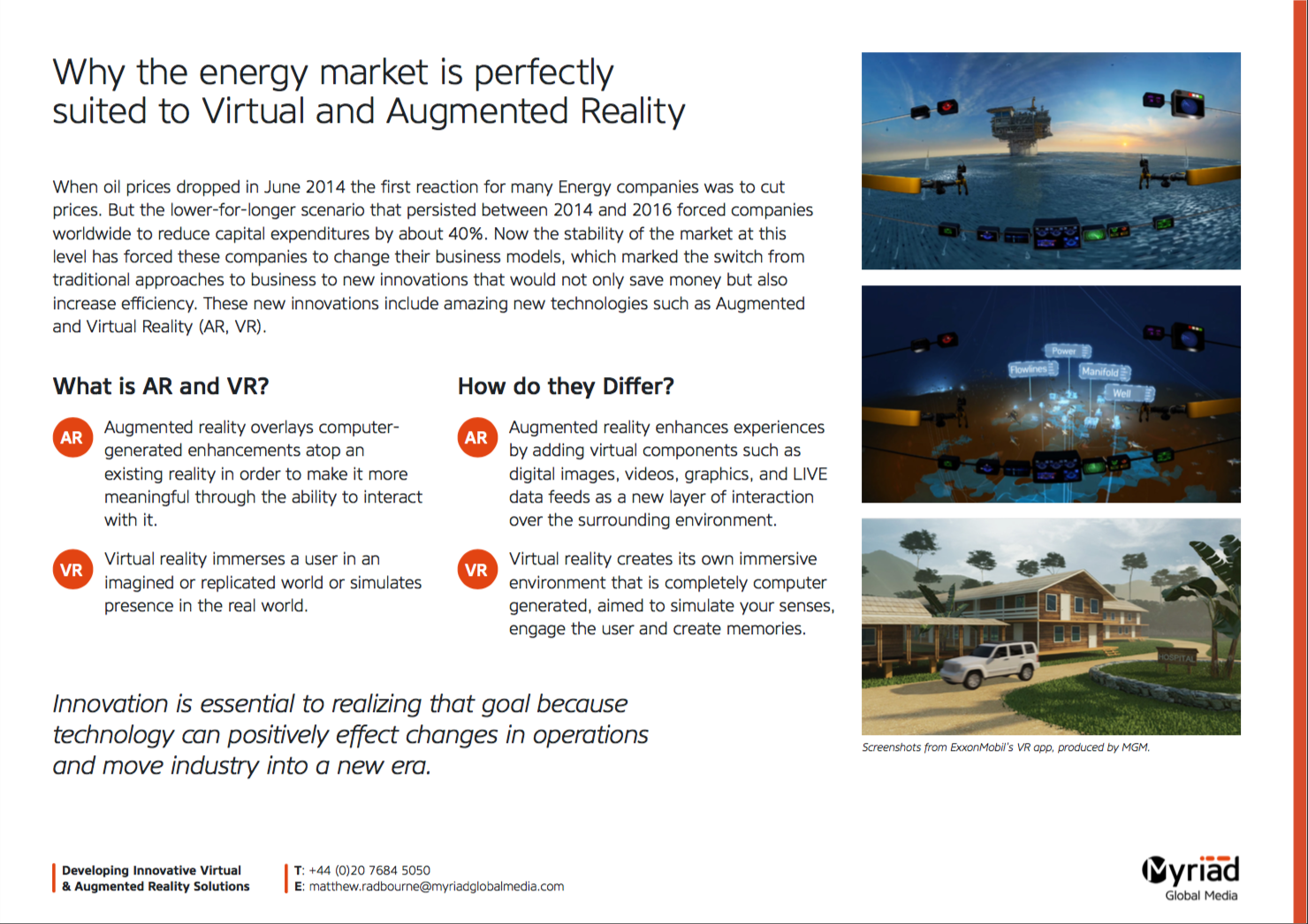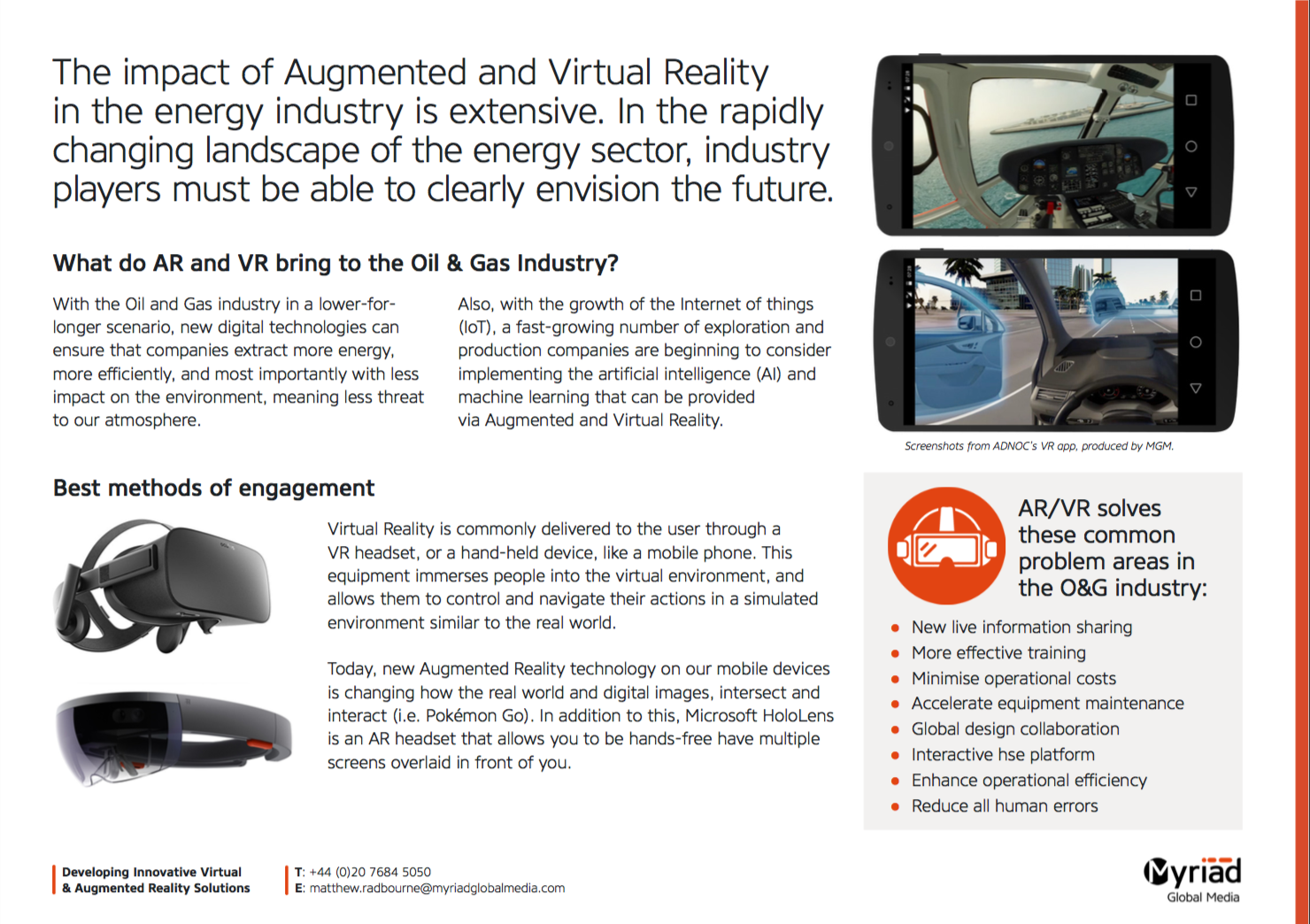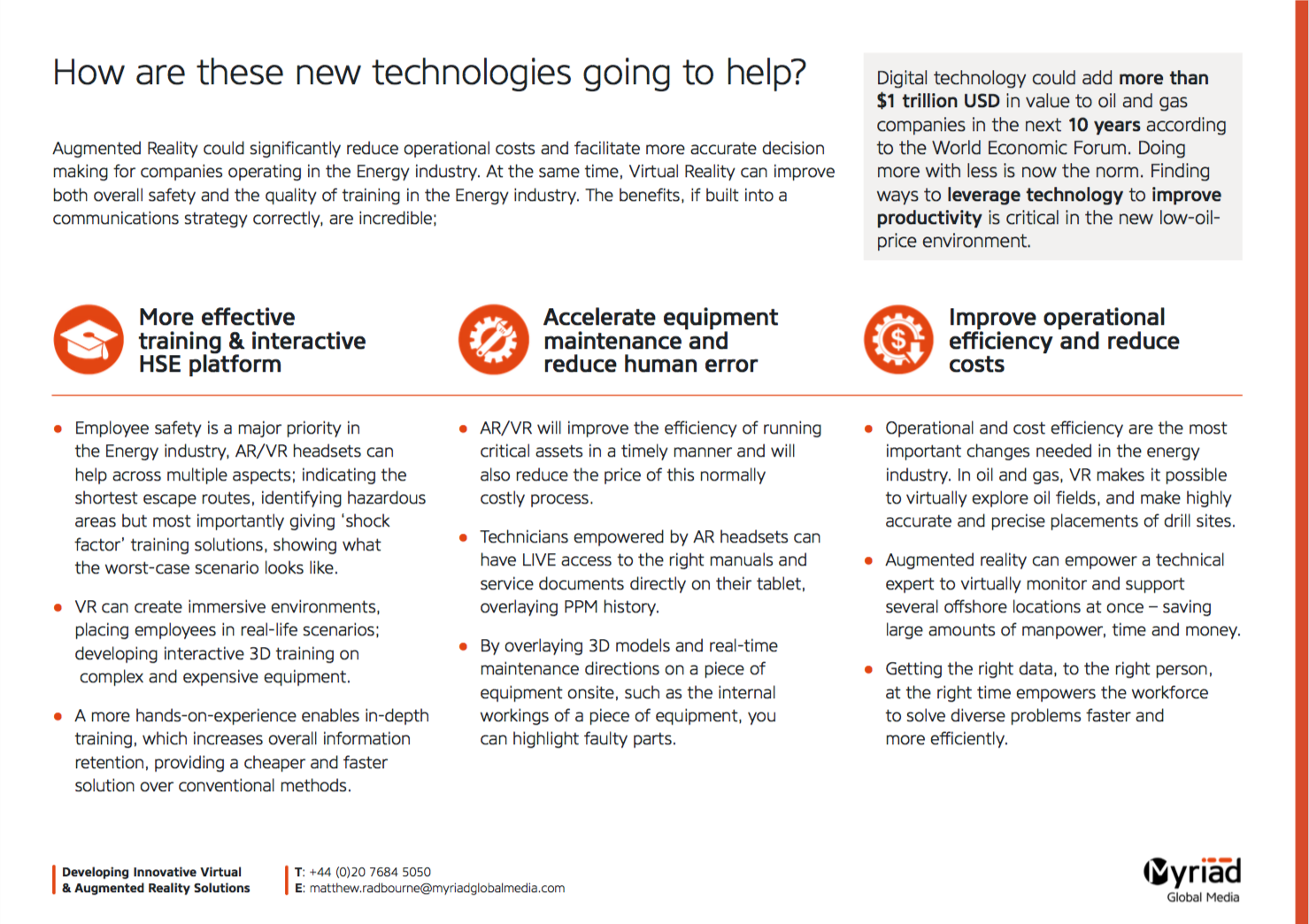Why the Energy Market loves Virtual & Augmented Reality
Why the Energy Market is perfectly suited to Virtual and Augmented Reality?
Hopefully, this will give you an insight into the huge positives surrounding Virtual and Augmented Reality, that are available to a sector that is looking for huge operational change. If the Energy sector (LNG, Renewables or Oil) is going to peak once again, there is a huge need to reduce operational costs, can Virtual and Augmented Reality be the answer?
Check us out on LinkedIn Slide Share – https://www.slideshare.net/MatthewRadbourne/virtual-and-augmented-reality-82886501
PAGE 1
Why the energy market is perfectly suited to virtual and augmented reality
When oil prices dropped in June 2014 the first reaction for many Energy companies was to cut prices. But the lower-for-longer scenario that persisted between 2014 and 2016 forced companies worldwide to reduce capital expenditures by about 40%. Now the stability of the market at this level has forced these companies to change their business models, which marked the switch from traditional approaches to business to new innovations that would not only save money but also increase efficiency. These new innovations include amazing new technologies such as Virtual and Augmented Reality (VR, AR).
What is Virtual and Augmented Reality?
- Augmented reality overlays computer-generated enhancements atop an existing reality in order to make it more meaningful through the ability to interact with it.
- Virtual reality immerses a user in an imagined or replicated world or simulates presence in the real world.
How do they Differ?
- Augmented reality enhances experiences by adding virtual components such as digital images, videos, graphics, and LIVE data feeds as a new layer of interaction over the surrounding environment.
- Virtual reality creates its own immersive environment that is completely computer generated, aimed to simulate your senses, engage the user and create memories.
Innovation is essential to realising that goal because technology can positively effect changes in operations and move industry into a new era.
PAGE 2
The impact of virtual and augmented reality in the energy industry is extensive. In the rapidly changing landscape of the energy sector, industry players must be able to clearly envision the future.
Best methods of engagement:
- Virtual Reality is commonly delivered to the user through a VR headset, or a hand-held device, like a mobile phone. This equipment immerses people into the virtual environment, and allows them to control and navigate their actions in a simulated environment similar to the real world.
- Today, new Augmented Reality technology on our mobile devices is changing how the real world and digital images, intersect and interact (i.e. Pokémon Go). In addition to this, Microsoft HoloLens is an AR headset that allows you to be hands-free have multiple screens overlaid in front of you.
What do Virtual and Augmented Reality bring to the Oil & Gas Industry?
With the Oil and Gas industry in a lower-for-longer scenario, new digital technologies can ensure that companies extract more energy, more efficiently, and most importantly with less impact on the environment, meaning less threat to our atmosphere.
Also, with the growth of the Internet of things (IoT), a fast-growing number of exploration and production companies are beginning to consider implementing the artificial intelligence (AI) and machine learning that can be provided via Virtual and Augmented Reality.
Virtual and Augmented Reality solve these common problem areas in the O&G industry:
- New live information sharing
- More effective training
- Minimise operational costs
- Accelerate equipment maintenance
- Global design collaboration
- Interactive HSE platform
- Enhance operational efficiency
- Reduce all human errors
PAGE THREE
How are these new technologies going to help?
Augmented Reality could significantly reduce operational costs and facilitate more accurate decision making for companies operating in the Energy industry. At the same time, Virtual Reality can improve both overall safety and the quality of training in the Energy industry. The benefits, if built into a communications strategy correctly, are incredible;
More effective training & interactive HSE platform
- Employee safety is a major priority in the Energy industry, Virtual and Augmented Reality headsets can help across multiple aspects; indicating the shortest escape routes, identifying hazardous areas but most importantly giving ‘shock factor’ training solutions, showing what the worst-case scenario looks like.
- VR can create immersive environments, placing employees in real-life scenarios; developing interactive 3D training on complex and expensive equipment.
- A more hands-on-experience enables in-depth training, which increases overall information retention, providing a cheaper and faster solution over conventional methods.
Accelerate equipment maintenance and reduce human error
- Virtual and Augmented Reality will improve the efficiency of running critical assets in a timely manner and will also reduce the price of this normally costly process.
- Technicians empowered by AR headsets can have LIVE access to the right manuals and service documents directly on their tablet, overlaying PPM history.
- By overlaying 3D models and real-time maintenance directions on a piece of equipment onsite, such as the internal workings of a piece of equipment, you can highlight faulty parts.
Improve operational efficiency and reduce costs
- Operational and cost efficiency are the most important changes needed in the energy industry. In oil and gas, VR makes it possible to virtually explore oil fields, and make highly accurate and precise placements of drill sites.
- Augmented reality can empower a technical expert to virtually monitor and support several offshore locations at once – saving large amounts of manpower, time and money
- Getting the right data, to the right person, at the right time empowers the workforce to solve diverse problems faster and more efficiently.
Digital technology could add more than $1 trillion USD in value to oil and gas companies in the next 10 years according to the World Economic Forum. Doing more with less is now the norm. Finding ways to leverage technology to improve productivity is critical in the new low-oil-price environment.


